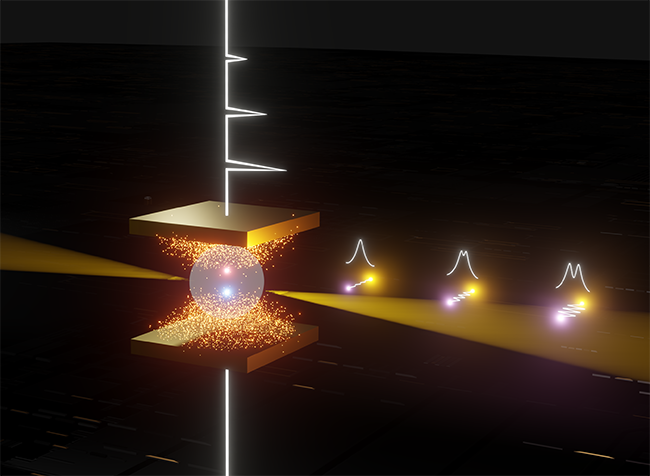Reviewed by Lexie CornerApr 9 2024
A research team led by Professor Kyoung-Duck Park and Hyeongwoo Lee, an integrated Ph.D. student from the Department of Physics at Pohang University of Science and Technology (POSTECH), introduced a groundbreaking technique in ultra-high-resolution spectroscopy.
 Image depicting the control of polariton particles using electric-field tip-enhanced strong coupling spectroscopy. Image Credit: Pohang University of Science and Technology
Image depicting the control of polariton particles using electric-field tip-enhanced strong coupling spectroscopy. Image Credit: Pohang University of Science and Technology
Their achievement represents the world's first successful instance of electrically controlling polaritons—hybridized light-matter particles—at room temperature.
Polaritons are hybrid particles characterized as "half-light, half-matter," possessing attributes of both photons (particles of light) and solid matter. Their special qualities show characteristics different from those of solid matter and conventional photons, opening up new possibilities for next-generation materials, especially in terms of exceeding optical display performance limits.
Their commercial viability has been hampered by their inability to electrically control polaritons on a single particle level at room temperature—that is, until now.
The researchers developed a brand-new technique known as “electric-field tip-enhanced strong coupling spectroscopy” that makes electrically controlled spectroscopy with ultra-high resolution possible. This novel method enables the room-temperature active manipulation of single polariton particles.
With the integration of ultra-precise electrical control and super-resolution microscopy—previously developed by Prof. Kyoung-Duck Park's team—this technique presents a novel approach to measurement.
The resulting device not only makes stable polariton generation possible at room temperature in a unique physical state known as strong coupling but also allows for the manipulation of the color and brightness of the light that the polariton particles emit by applying an electric field. One significant benefit is the use of polariton particles rather than quantum dots, which are essential components of QLED televisions.
A single polariton particle can produce all light colors with noticeably increased brightness. This removes the requirement for three different kinds of quantum dots to produce green, blue, and red light independently. This feature is electrically controllable in a manner similar to that of traditional electronics. Academically speaking, the group has solved a long-standing enigma in the study of polariton particles by successfully establishing and experimentally validating the quantum-confined stark effect in the strong coupling regime.
The team's success is highly significant as it represents a scientific advance that opens up new avenues for future research focused on developing polariton-based optical components and a variety of optoelectronic devices. This discovery has the potential to significantly advance industry, especially in the optical display sector, where it will serve as a vital source of technology for the creation of innovative products like small and incredibly bright outdoor displays.
A significant discovery with the potential to drive advancements across numerous fields, including next-generation optical sensors, optical communications, and quantum photonic devices.
Hyeongwoo Lee, Study Lead Author, Department of Physics, Pohang University of Science and Technology
The Sungkyunkwan University teams of Professors Sohee Jeong and Jaehoon Lim created the quantum dots used in the study. Professor Markus Raschke of the University of Colorado and Professor Matthew Pelton of the University of Maryland conducted the data analysis, while Professor Alexander Efros of the Naval Research Laboratory created the theoretical model.
The measurement work was done by Yeonjeong Koo, Jinhyuk Bae, Mingu Kang, Taeyoung Moon, and Huitae Joo from the Physics Department at POSTECH.
This work was funded by the Samsung Future Technology Incubation Program.
Journal Reference:
Lee, H., et al. (2024) Electrically Tunable Single Polaritonic Quantum Dot at Room Temperature. Physical Review Letters.doi.org/10.1103/PhysRevLett.132.133001